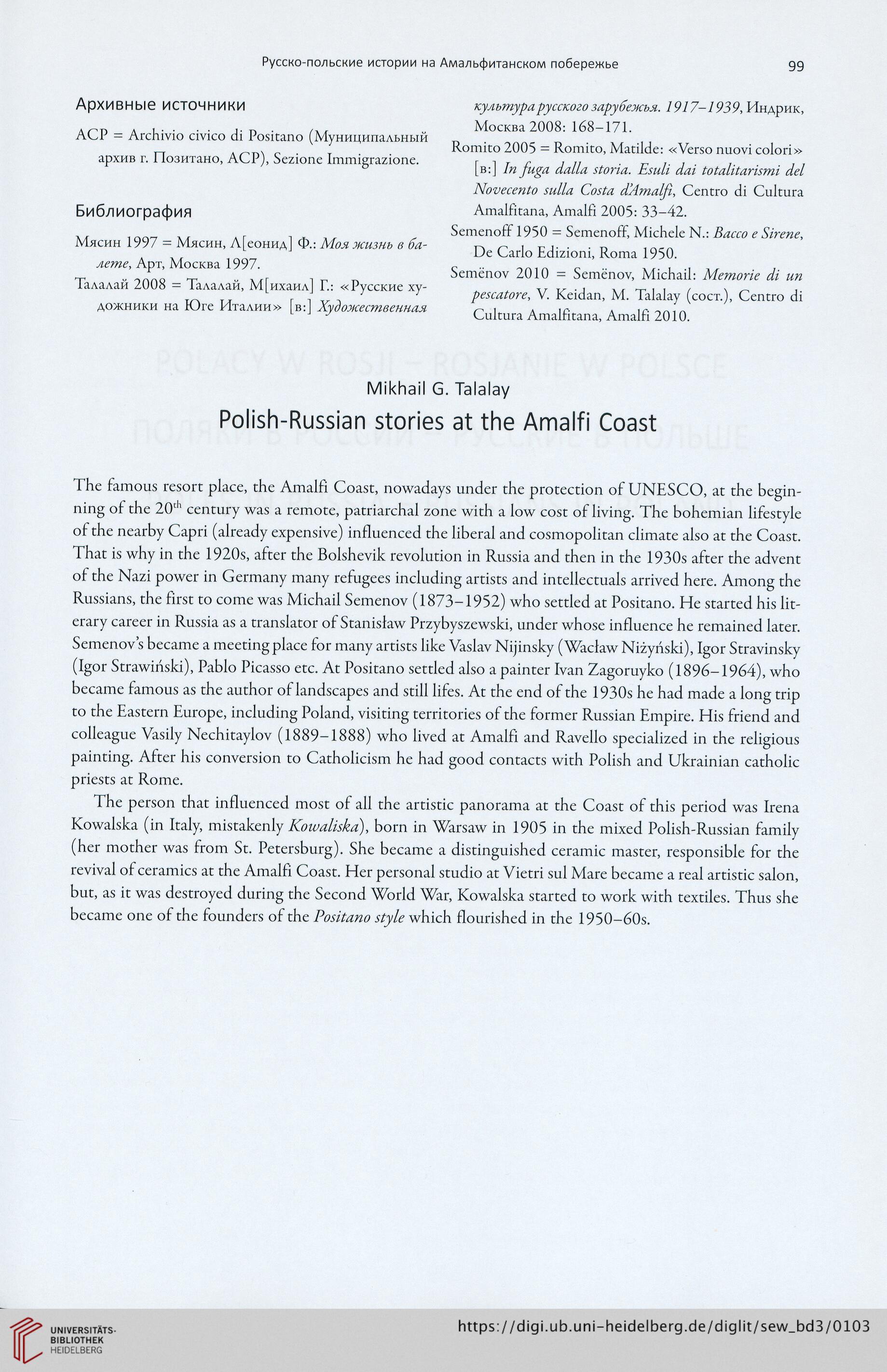Русско-польские истории на Амальфитанском побережье
99
Архивные источники
АСР — Archivio civico di Positano (Муниципальный
архив г. Позитано, АСР), Sezione Immigrazione.
Библиография
Мясин 1997 = Мясин, А[еонид] Ф.: Моя жизнь в ба-
лете, Арт, Москва 1997.
Талалай 2008 = Талалай, М[ихаил] Г.: «Русские ху-
дожники на Юге Италии» [в:] Художественная
культура русского зарубежья. 1917-1939, Индрик,
Москва 2008: 168-171.
Romito 2005 = Romito, Matilde: «Verso nuovi colori»
[в:] In fuga dalia storia. Esuli dai totalitarismi del
Novecento sulla Costa d’Amalfi, Centro di Cultura
Amalfitana, Amalfi 2005: 33-42.
Semenoff 1950 = Semenoff, Michele N.: Bacco e Sirene,
De Carlo Edizioni, Roma 1950.
Semenov 2010 = Semenov, Michaił: Memorie di un
pescatore, V. Keidan, M. Talalay (сост.), Centro di
Cultura Amalfitana, Amalfi 2010.
Mikhail G. Talalay
Polish-Russian stories at the Amalfi Coast
The famous resort place, the Amalfi Coast, nowadays under the protection of UNESCO, at the begin-
ning of the 20th century was a remote, patriarchal zonę with a Iow cost of living. The bohemian lifestyle
of the nearby Capri (already expensive) influenced the liberał and cosmopolitan climate also at the Coast.
That is why in the 1920s, after the Bolshevik revolution in Russia and then in the 1930s after the advent
of the Nazi power in Germany many refugees including artists and intellectuals arrived here. Among the
Russians, the first to come was Michaił Semenov (1873-1952) who settled at Positano. He started his lit-
erary career in Russia as a translator of Stanisław Przybyszewski, under whose influence he remained later.
Semenov s became a meetingplace for many artists like Vaslav Nijinsky (Wacław Niżyński), Igor Stravinsky
(Igor Strawiński), Pablo Picasso etc. At Positano settled also a painter Ivan Zagoruyko (1896-1964), who
became famous as the author of landscapes and still lifes. At the end of the 1930s he had madę a long trip
to the Eastern Europę, including Poland, visiting territories of the former Russian Empire. His friend and
colleague Yasily Nechitaylov (1889-1888) who lived at Amalfi and Ravello specialized in the religious
painting. After his conversion to Catholicism he had good contacts with Polish and Ukrainian catholic
priests at Romę.
The person that influenced most of all the artistic panorama at the Coast of this period was Irena
Kowalska (in Italy, mistakenly Kowaliska), born in Warsaw in 1905 in the mixed Polish-Russian family
(her mother was from St. Petersburg). She became a distinguished ceramic master, responsible for the
revival of ceramics at the Amalfi Coast. Her personal studio at Vietri sul Marę became a real artistic salon,
but, as it was destroyed during the Second World War, Kowalska started to work with textiles. Thus she
became one of the founders of the Positano style which flourished in the 1950-60s.
99
Архивные источники
АСР — Archivio civico di Positano (Муниципальный
архив г. Позитано, АСР), Sezione Immigrazione.
Библиография
Мясин 1997 = Мясин, А[еонид] Ф.: Моя жизнь в ба-
лете, Арт, Москва 1997.
Талалай 2008 = Талалай, М[ихаил] Г.: «Русские ху-
дожники на Юге Италии» [в:] Художественная
культура русского зарубежья. 1917-1939, Индрик,
Москва 2008: 168-171.
Romito 2005 = Romito, Matilde: «Verso nuovi colori»
[в:] In fuga dalia storia. Esuli dai totalitarismi del
Novecento sulla Costa d’Amalfi, Centro di Cultura
Amalfitana, Amalfi 2005: 33-42.
Semenoff 1950 = Semenoff, Michele N.: Bacco e Sirene,
De Carlo Edizioni, Roma 1950.
Semenov 2010 = Semenov, Michaił: Memorie di un
pescatore, V. Keidan, M. Talalay (сост.), Centro di
Cultura Amalfitana, Amalfi 2010.
Mikhail G. Talalay
Polish-Russian stories at the Amalfi Coast
The famous resort place, the Amalfi Coast, nowadays under the protection of UNESCO, at the begin-
ning of the 20th century was a remote, patriarchal zonę with a Iow cost of living. The bohemian lifestyle
of the nearby Capri (already expensive) influenced the liberał and cosmopolitan climate also at the Coast.
That is why in the 1920s, after the Bolshevik revolution in Russia and then in the 1930s after the advent
of the Nazi power in Germany many refugees including artists and intellectuals arrived here. Among the
Russians, the first to come was Michaił Semenov (1873-1952) who settled at Positano. He started his lit-
erary career in Russia as a translator of Stanisław Przybyszewski, under whose influence he remained later.
Semenov s became a meetingplace for many artists like Vaslav Nijinsky (Wacław Niżyński), Igor Stravinsky
(Igor Strawiński), Pablo Picasso etc. At Positano settled also a painter Ivan Zagoruyko (1896-1964), who
became famous as the author of landscapes and still lifes. At the end of the 1930s he had madę a long trip
to the Eastern Europę, including Poland, visiting territories of the former Russian Empire. His friend and
colleague Yasily Nechitaylov (1889-1888) who lived at Amalfi and Ravello specialized in the religious
painting. After his conversion to Catholicism he had good contacts with Polish and Ukrainian catholic
priests at Romę.
The person that influenced most of all the artistic panorama at the Coast of this period was Irena
Kowalska (in Italy, mistakenly Kowaliska), born in Warsaw in 1905 in the mixed Polish-Russian family
(her mother was from St. Petersburg). She became a distinguished ceramic master, responsible for the
revival of ceramics at the Amalfi Coast. Her personal studio at Vietri sul Marę became a real artistic salon,
but, as it was destroyed during the Second World War, Kowalska started to work with textiles. Thus she
became one of the founders of the Positano style which flourished in the 1950-60s.




